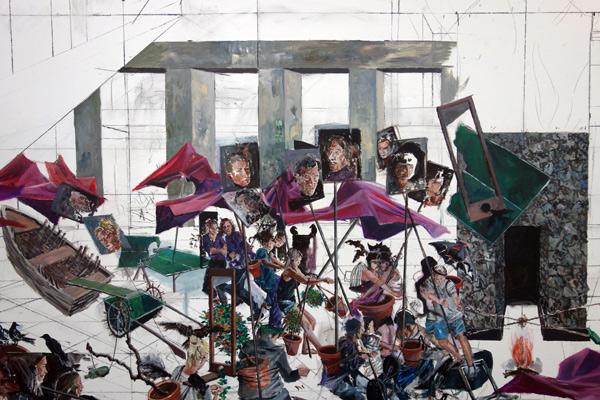Afternoon
The work “Afternoon”, whose genesis, from empty canvas to detailed completion of the images on the web, is documented daily in 2-3 photos and is 600 x 330cm in size. The planned completion date of the work is 2017.
 “Afternoon” is part of an artistic realisation of an idealized working day, which extends over an entire life and is divided into five stages: “Morning” (600 x 600cm) was started as a student (1988-1991), “Mid-morning” (600 x 330cm) followed, which accompanied the initial years after the completion of studies (1992-1995), then “Noon” on eight panels (each 200 x 300cm), which linked to a phase of mid-life (1995-2000). Now, after a work-filled break lasting almost 10 years, “Afternoon” (in the same format as “Mid-morning”) describes the transformation from mid-life to later life, which does not yet include the “sum” of a life although a “harvest” has already started. Then “Evening” is planned as a last stage, which in turn parallels “Noon” on eight panels (each 200 x 300cm), and allows the day to turn into a twilight, through which it is finally ended. “Night”, as the connection from one morning to the next in the sense of a cycle in time, rather than an irreversible succession of characteristic phases, is not specifically realised, but should also be picked out as a central theme in its own respective way in each of the individual times of day.
“Afternoon” is part of an artistic realisation of an idealized working day, which extends over an entire life and is divided into five stages: “Morning” (600 x 600cm) was started as a student (1988-1991), “Mid-morning” (600 x 330cm) followed, which accompanied the initial years after the completion of studies (1992-1995), then “Noon” on eight panels (each 200 x 300cm), which linked to a phase of mid-life (1995-2000). Now, after a work-filled break lasting almost 10 years, “Afternoon” (in the same format as “Mid-morning”) describes the transformation from mid-life to later life, which does not yet include the “sum” of a life although a “harvest” has already started. Then “Evening” is planned as a last stage, which in turn parallels “Noon” on eight panels (each 200 x 300cm), and allows the day to turn into a twilight, through which it is finally ended. “Night”, as the connection from one morning to the next in the sense of a cycle in time, rather than an irreversible succession of characteristic phases, is not specifically realised, but should also be picked out as a central theme in its own respective way in each of the individual times of day.
All five phases of the working day or working life are linked to each other through a system of 24 figures (following the arbitrary division of the day into 24 hours): In “Morning”, in the construction of an eight-petalled circular flower, one figure per petal and ray multiply by the number three (for a division of the day “without transitions”: morning – noon – evening) to become 24 figures, which appear in each of the eight segments of the circle on the extreme concentric circle of the construction, giving a total of 8 x 24 figures. In “Mid-morning”, the 24 figures arrive on Earth on a ray of morning, so to speak, and distribute themselves in accordance with 24 rudimentarily different fields of activity in a centralistic and horizontally aligned architecture. In the subsequent “Noon”, the 24 figures distribute themselves in groups of three (one female and two male in each) in a total of eight images in various, mutually typologically delimited indoor and outdoor scenarios.
“Afternoon” again brings together the 24 figures in accordance with the scheme of “Morning” in a single scenario, which now appears to be no more than the addition of apparently independent individual treatments, but all figures pull figuratively and literally on a rope: this rope is interwoven into a knot in the centre of the image, from which four ends lead to four opposing sides of the image according to the divisions of the points of the compass. Six figures pull on each of the four pieces of rope (three male, three female), as if they were in a tug-of-war in a sporting competition. Relics of the attempts of morning, and reminders of the critical moments of the entanglements at noon, the four competitive groups move into a tight network of textual references during their pretend conflict. No symbolism replaces the communicative ties of their disparate present in order to restrict the data loss of their free contacts. The covert doubling of the number of ends of a single knot remains one of the constructive contradictions that “Evening” will finally have to clarify.